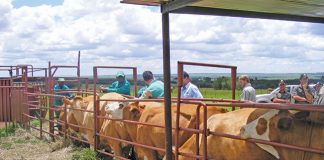In the final part of this series, Peter Hittersay offers advice on how to drive and operate a tractor safely, as well as keep it clean and in good condition.
Driving tips
- Mount and dismount using the foot- and handholds on the left side of the tractor.
- Adjust the seat so that you can reach all the controls safely – and latch it securely.
- Always apply the handbrake when stopped.
- Latch the footbrakes during on-road driving and unlatch them when working on the field in narrow headlands requiring tight turns.
- Don’t keep your foot on the clutch pedal when driving.
- Keep both hands on the steering wheel unless changing gear or operating controls.
- Select the correct gear before entering the land to be worked. When travelling on the road, especially with a loaded trailer, anticipate the next gear change and change up or down without stopping.
- If you’ve stopped on a slope and engaged the handbrake, drive off in the following manner: select the correct gear, then let out the clutch gently while releasing the handbrake and increasing the engine speed with the foot throttle.
- To hitch a trailer, make sure the swinging drawbar of the tractor is locked in the central position, then reverse the tractor and insert and secure the trailer’s drawbar pin. Fit the safety chain and, if fitted, couple the hydraulic and air-brake lines.
- Adapt your speed to the load and terrain, and keep it constant.
- To stop in an emergency, apply the footbrake and clutch while closing the throttle.
- When towing another vehicle such as a tractor stuck in mud, use the drawbar and never the top brackets of the three-point linkage, as this could cause an accident.
- When hitching three-point linkage-mounted implements, attach the left lower linkage arm first, then the right arm, and finally, the top link.
Cleaning
This offers several benefits:
- It prevents dirt from entering the engine.
- It allows you to identify oil leaks, loose nuts, cracked housings and other faults more quickly.
- It enables you to work on the tractor more easily.
Precautions
• Let the engine cool off first – pouring cold water on a hot engine could crack the block.
• Cover the exhaust outlet with a tin to prevent water entering the exhaust system.
• Cover the alternator/generator with a plastic bag.
• Cover the instruments and don’t point the hosepipe at them.
• Don’t spray directly onto any lights.
Method
• Start by using paraffin to remove grease and oil.
• Clean and remove battery acid with clean, warm water.
• Wet the tractor with clean water.
• Wash it using a soft cloth and mild, soapy water.
• Dry it with a soft cloth.
• Polish it with a motor car wax compound.
Undercover storage
Storing your tractor properly prevents sun and wind damage to the paintwork, tyres, seat and instruments. It also stops rain from finding its way into instruments, the electrical system and the seat. To build a suitable shelter, simply put up four poles supporting a thatched, plywood or tin roof. Use the same material to construct a wall on the side of the prevailing wind.
Acknowledgments
This series was based on a tractor and implement operating and maintenance training course for small-scale farmers, operators and contractors. The course was originally commissioned by, and developed for, the SA Cane Growers’ Association by Peter Hittersay, who later revised it for the Limpopo agriculture department’s Agribusiness Development Academy. Peter is grateful to both parties for their permission to reproduce course material in Farmer’s Weekly.
Caption:
Driven with care and looked after well, your tractor will give you many years of safe, productive service.
FW ARCHIVE












